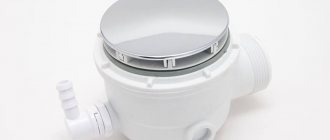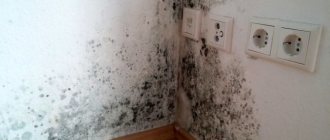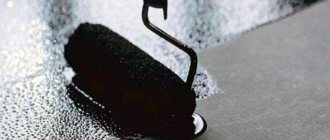The presence of an unpleasant odor from the shower drain indicates the absence of a water seal. That is, about incorrect installation of the drain siphon. You will have to crawl under the cabin and reinstall the siphon. It must be mounted so that the horizon of the water sink is completely filled with water. Otherwise, in addition to the unpleasant odors of the communal sewage system, entire armies of pathogenic bacteria and pathogenic fungi begin to penetrate into the apartment.
If you have a siphon under the pan, then you need to take measures to clean and rinse it.
Apparently the fat and dirt accumulated in it are actively decomposing and bacteria are multiplying, as a result of which you feel an unpleasant odor, so you need to use cleaning agents, something like mole or mechanically disassemble and rinse/clean the siphon.
If you do not have such a siphon, and the drain of the shower stall is made directly into the riser, then such a siphon must be installed, otherwise you will continue to smell odors from the sewer.
What to do if it is not possible to install a siphon, then the second option is to use a plug to close the drainage hole when the shower stall is not in use, thus minimizing the entry of odors into the room.
By the way, many people have this problem due to the impossibility (lack of space) of installing a siphon under the shower tray; people connect the drainage directly, and put a valve on the neck instead of a standard grille.
It is very convenient, the principle of operation is like a stopper in a thermos, double pressing, pressed open, pressed closed, just stepped on and the drainage opened, stepped on again after taking a shower and the drainage is tightly closed with the stopper.
Users of shower cabins often encounter this problem: after taking water procedures, the liquid leaves the tray very slowly.
The reasons for this can be completely different: a clogged siphon, a common sewer, or an incorrect installation of the cabin.
All these factors can lead not only to poor drainage, but also to the appearance of an unpleasant odor. In our article we will talk in detail about the reasons for slow drainage, as well as how to remove the blockage and clear the drain in the shower without consequences for the plumbing. After all, the use of aggressive chemicals can damage the siphon and pipes .
The shower smells like sewage, what should I do and why does it stink in the shower?
An unpleasant problem often arises - the shower smells like sewage, what to do in such cases?
It is impossible to use a shower that stinks of sewage. The entire procedure, which uses fragrant shampoos and other products, can be ruined. Moreover, the smell gradually spreads throughout the apartment. Let's look at why your shower stall smells like sewer and how to stop it.
- Where does the smell come from?
- Siphon, water seal
- Why does the water seal sometimes not work?
- How to deal with unpleasant odor
- Video review:
Video review:
First: ventilation is not done, ventilation not only removes odors, it regulates the pressure, apparently you have pressure drops in the pipe, the smell is not retained by the siphon.
Correction method: From the central sewer riser, move the pipe straight up (vertically); the vertical pipe should be the same diameter as the main one (usually 110 mm).
Second: The siphon is not working well, there is a water lock, but the siphon is clogged, we fix the problem by simply cleaning the sump, it is not necessary to remove the entire siphon, cleaning is provided on normal siphons (unscrew one nut), if there is no cleaning, then unscrew the nut from the siphon mounting.
Still, it’s better to buy it with cleaning, it’s convenient.
Third: Incorrect or insufficient slope of the main sewer pipe; the slope should be two centimeters per meter of pipe, towards the cesspool.
I understand that the pipe is in the ground, but if nothing helps, there is only one option, dig it up and lay it correctly.
Start small, clean the siphon.
the author of the question chose this answer as the best
If it is clear where the smell is coming from, for example from a cesspool, then it is clear that the smell is due to poor sealing, that is, there are holes between the shower and the cesspool. These holes need to be sealed so that bad air does not penetrate into the shower.
In general, why can the bathroom sometimes smell like sewage?
There may be several reasons:
1 One of the reasons is old pipes that are covered with a thick layer of black, smelly dirt. In this case, it's time to change the pipes.
2 Another reason may again be old materials. For example, the house was built a long time ago, there was constant dampness and mold could grow on bare cement areas. Then you need to clean it and paint it with several layers of new paints.
3 The cat (or other pet) pooped in the bathtub. And when water flows under the bathtub, upon contact with feces, it becomes wet and begins to smell. Or some food item fell under the bathtub and began to decompose.
4 If there is a hole between the toilet and the bathroom, for example around a thick (faucet) pipe, then odors from the toilet can penetrate into the bathroom.
5 Odors from other apartments can reach you through the ventilation hole.
6 There may be a smell from the water outlet (there are two of them). They are connected to a thick (faucet) pipe, which, as you know, connects to the toilet. That is, this is essentially a sewer. In this case, the smell may be due to the fact that the toilet is not flushed well (perhaps the drain is bad or they are lazy). Or from old pipes on which dirt has grown.
7 Water flows under the bathtub and there it begins to go out like stagnant water. Here you need to minimize leakage and clean out the accumulated rotten matter.
add to favorites link thank
There may be reasons related to both the cesspool itself and the hydraulic seal. The fact is that the hydraulic valve serves. to prevent the penetration of foreign odors from the cesspool into the shower stall. But there are times when the hydraulic valve is in order, and the stench from the cesspool gets into the shower stall. This may be caused by increased pressure forming in the cesspool. And this can be caused by clogging of the cesspool ventilation or design flaws. After eliminating which, unpleasant odors disappear. And of course, the stench can come from the pipe itself if dirt accumulates in the hydraulic seal, and this requires flushing.
add to favorites link thank
The most obvious reason is that the siphon does not work well, or does not exist at all. A siphon is the easiest way to keep sewer gases out of your drain. It serves as a hydraulic lock for sewer gases. That is, it is a curved pipe filled with a certain level of liquid. if this level is incorrect, gases may enter. You should inspect the siphon for damage, or install another, more capacious one, that is, with a larger supply of water.
add to favorites link thank
Dear visitor! You are in the archive of the old forum on the mastergrad website. com
The main causes of unpleasant odor
- There may be a plastic smell. This situation often happens with new inexpensive shower enclosures. It is almost impossible to fight this feature. Perhaps over time this unpleasant odor will disappear completely.
- The second reason for the appearance of an unpleasant odor is stagnation of water. This problem may be due to the lack of a drain valve, which should be used to drain the remaining water from the overhead shower. To solve the problem, experts recommend purchasing and installing an air bleed valve. This element must be mounted on top of the connection between the hose and the shower.
- The third common reason is an error during the installation of the drain structure, in particular the lack of a water seal. This happens if the drain was installed straight and there were no bends. If there is a sewer smell coming from the shower stall, you can try to solve the problem by disassembling the siphon and drain pipe located under the pan. It is necessary to re-install the structure, taking into account all technical recommendations, which indicate the need for bending the corrugation.
- The cause may not be identified. This applies to situations where all actions during the assembly process were performed correctly, but despite this, the sewer smell is still present in the shower. To solve this problem, experts recommend installing a good quality check air valve. It is believed that such a product prevents the occurrence of unpleasant sewer odors in the bathroom. Typically, this valve should be installed on a drain pipe.
- Another reason may be poor drain performance due to its small volume. Very often, such an element simply cannot cope with the amount of water passing through it. To fix the problem, you need to remove the existing drain and install a new element. An excellent solution to the problem would be to install a turbo drain, which is large in size. It is also worth noting that the channels in it have the shape of a spiral, so there is no retention of water and it does not rot.
Other causes of unpleasant odor and methods of elimination
An unpleasant smell in the bathroom can occur for many reasons, it could be a wet item left under the bathtub, mold formation due to high humidity that grows on ceramic tiles, or a bad smell from the vent spreading throughout the room.
Why is the water seal broken?
There may be several reasons for this phenomenon, so it is important to consider each case separately:
- The most common reason is improper installation of the siphon. If an ordinary product is installed that looks like a flask, where the pipe is not provided for lowering into the water inside the siphon, then most likely there will still be an unpleasant odor. It easily passes between the water and the walls of the device, thus freely entering the room. To prevent such a situation and make the water retain unpleasant odors again, you just need to lower the pipe into the water a few centimeters lower. Only it should not fall so that it rests against the bottom of the siphon.
- The problem may arise due to sagging of the corrugated tube. If you bend the elbow correctly, the corrugated tube will retain a certain amount of water at the lower level. As a result, the required water seal will be created in the system. After some time, the corrugation loses its rigidity and begins to sag, as a result of which the water level decreases and the water seal disappears. To prevent this situation, you can use special clamps that hold the tube in the correct position for a long time. You can also use regular electrical tape, which can be used to tie the tube as it should be.
- Often an unpleasant odor occurs due to fumes emanating from the siphon. As a rule, this happens due to long downtime of sewerage devices. If the system is not used, the water from the siphon will simply evaporate, and the water seal will break. Many owners of houses and apartments are interested in how to remove this smell and what measures can be taken to prevent this situation? Everything is much simpler than it seems at first glance. Before a long trip, it is recommended to pour a little vegetable oil into the drain hole of the plumbing fixture. Thus, due to the formation of a special film, water will not evaporate from the siphon. If such an incident could not be avoided, then you just need to drain more water to flush the siphon that has accumulated sewer odor.
- Installation errors or savings can also cause unpleasant odors. Illiterate professionals can overstretch the corrugated pipe or secure it in the wrong condition, which will result in a broken or missing water seal. In such situations, a bad smell appears immediately after the installation of new plumbing fixtures.
Damp smell in the bathroom: how to get rid of it
In addition to sewer odors, you can often notice the smell of dampness in the bathroom. This problem also needs to be dealt with mercilessly, and not try to disguise it. Regular inhalation of mold and mildew particles can trigger the development of asthma and allergies, as well as other upper respiratory tract diseases.
The causes of dampness in the bathroom are usually poor ventilation and insufficient heating of the room. Therefore, first of all, start cleaning the ventilation duct. Sometimes it is enough to simply wash the ventilation grille of dust. But in most cases, it is worth installing a small fan in the ventilation duct to ensure more efficient removal of moist air.
Important! Be sure to turn on forced ventilation when taking a bath or shower to prevent moisture from accumulating in the room.
Remember to ventilate the bathroom after use. Leave the door open more often and ventilate the apartment at the same time. In particularly difficult cases, you can install an absorption moisture absorber in the bathroom - such devices are available from Metylan and Henkel, and can be purchased at large home improvement supermarkets. If your bathroom area is more than 10 square meters, it is better to install an electric dehumidifier instead of an absorption one.
A note to shower cabin owners: how to clean an acrylic tray from dirt.
Don't forget about good heating in the bathroom. Install a good heated towel rail, preferably an electric one. The latter is especially important if in your home this plumbing fixture is connected to heating and not to a hot riser. Installing an electric heated towel rail will allow you to maintain normal levels of temperature and humidity in the bathroom even outside the heating season. And after bringing the humidity level back to normal, be sure to clean the room of traces of fungus and mold in order to get rid of the smell of dampness forever.
Ventilation pipe problems
An equally common cause is ventilation pipes. All it takes is a slight twist or deviation from the correct location to create an unpleasant odor. Also, due to prolonged use, plaque may develop inside the pipe. In such a situation, the pipeline must be cleaned so that it can again perform its function.
To prevent this from happening, it is advisable to periodically inspect the ventilation and promptly remove contaminants that could become a source of stench.
Arranging a shower stall drain and installing a siphon
Installation of the drainage device is carried out in a certain sequence to ensure the correct functioning of the system and guarantee a permanent flow of water.
- Preparatory work. The shower tray is turned upside down and the pins purchased as a set are screwed into it. Nuts are screwed onto the threaded shanks to limit the elements of the load-bearing frame, which are then placed on the studs. A siphon with a hose is inserted into the hole in the pan.
- Setting the drain angle. Using a building level, the frame is mounted so that it rises approximately 2 cm above the bottom point of the siphon. It, in turn, should be approximately 5 degrees higher than the sewer tee (relative to the horizontal) to ensure a guaranteed outflow of used water. The power structure is secured with nuts, the hose is connected to the tee and the drain is checked. If the water does not drain quickly enough, the slope is increased using the adjusting screws.
- Final installation and connection. A mesh is placed in the drain hole, having previously coated it with silicone sealant for a tighter fit. Place a gasket, screw on the sewer tee and connect it to the outlet, making sure to place a sealant at the junction. The outlet is inserted into the sewer pipe, the connection is sealed with silicone and tightly fixed with a coupling.
A useful device is the overfill prevention system. It is installed in the same way as a drain siphon. You just need to additionally connect the overflow hole with the tee, sealing them along the joint line.
Sources of stench - common options
Modern houses are equipped with a sophisticated sewer system designed to remove residual waste products. Its operation is accompanied by specific odors, since wastewater flowing through the pipes emit hydrogen sulfide and other unpleasant-smelling substances.
When the sewerage system is working properly, the “aroma” in the premises (including the bathroom, kitchen, toilet) is almost imperceptible. Its appearance indicates a malfunction in the functioning of technical communications or plumbing fixtures.
The most common causes of stench can be:
- Mistakes made when installing the sewer system. The appearance of odors in the room may be due to improper installation of pipes or loose connections.
- Burst of a sewer pipe in the central or apartment distribution system. A leak can be either obvious or almost invisible: a microcrack or a joint not treated with sealant is often enough for gases and moisture to leak through.
- Inadequate assembly quality of the siphon or its malfunction. This component of plumbing design plays an important role in preventing the entry of foul gases.
- Blocked pipes or drains. Household waste, hair, and food waste that accumulate in siphons or pipes begin to rot, releasing a specific “aroma.”
- A malfunction in the operation of the water seal, as a result of which the “water plug” is destroyed, which prevents the appearance of sewer odors.
- Defects in the functioning of ventilation, which is equipped in apartment and private buildings. The system is designed to remove stench from the sewer system; If she doesn't do a good job, the stench penetrates the apartments.
- Incorrect connection or violation of operating instructions for the washing machine. In some cases, a useful unit becomes a source of a specific odor.
We suggest you read: How to remove the unpleasant odor of pork meat
In addition to those listed, there are many other reasons that cause “odors” in the room. Some of them are easily removable, others require the help of specialists, and often extensive, expensive work.
Below we will look in detail at the various sources of stench and tell you what measures need to be taken in specific cases.
Image gallery
Photo from
Odor is the cause of sewerage problems
Lack of ventilation and blockages in pipes
Siphon clogged and water seal leaking
Major damage to pipes and equipment
Why does the shower smell? How to eliminate the causes of odor in the shower.
The shower room and bathroom are a place where we rest and relax. It is very important that there is an appropriate atmosphere here. Fragrant smells, light music. An unpleasant smell in the shower is completely out of place. However, as in the whole house.
Causes of odor in the shower
- The drain built into the shower stall does not have a water seal.
- There is no water in the water seal or it is clogged.
- Malfunction of the drain pipe.
How to get rid of the smell in the shower?
- You can find out whether a water seal is built into the shower drain by visual inspection. It is enough to remove the facing grille from the ladder.
Construction of the drainage system
The components of the sewer system include:
- pipes of various diameters necessary to drain water from the bathroom;
- ventilation and sewage risers;
- pressure manifold;
- water drainage lines.
Not only the bathroom, but also the shower room is connected to the system in a private house. The lowest point of the system is the wastewater outlet. A ventilation valve is installed on the top. This point is located above all water intake nodes. The functions of the valve include sealing the system so as not to allow harmful gases and odors to enter the room.
All outlets of the system into the collector are connected to the lower point ending with the siphon. This includes a bathroom and shower. All pipes must slope towards the collector well. An ideal sewer system does not have sharp turns of 90 degrees, and there are no changes in height within one branch.
What if the toilet smells like sewer?
There is a sewer smell in the toilet, what could be the reason? The toilet is another matter. Here, it seems, the shutter is built into the toilet, and there is no special installation, but the smell is there. What is the reason, what is wrong here? In this matter, everything is a little more complicated.
The problem of unpleasant “orange” in the toilet room is a consequence of improper installation of sewer pipes, namely failure to comply with the required pipe slope standards when laying them. Due to errors of this kind, the pressure inside the sewer system breaks through the water barrier in siphons and valves, and foul odors escape into our apartment.
Condensation Formation
The reason for the formation of condensation on sewer pipes is the difference in temperatures outside and inside the pipe. Because of this, mold and mildew may appear in places where condensation accumulates, causing an unpleasant odor. In addition, they are also very harmful to health. The fungus appears in rooms with high air humidity, and it is extremely difficult to get rid of it.
This problem can be avoided if you constantly monitor the condition of the pipes. If condensation is detected, the pipeline should be wiped and insulated (for more details: “How to remove condensation from cold water pipes - eliminating causes and consequences”). Thanks to this, in the future there will be no large temperature difference, and therefore the formation of wet marks.
The pipes should be located in such a way that they are easy to reach. If they are located in a place where access is difficult, eliminating the problem will become problematic. The slightest crack in a pipe can lead to the need to dismantle a large part of the room to get to it.
Preventative measures to prevent sewer stench
Simple preventative measures will help prevent the appearance of odors from the kitchen chimney:
- Do not allow food debris to enter the drain.
- Install a household waste disposer.
- Equip drain holes in the bathroom and kitchen with special grilles that trap dirt.
- Do not use Mole frequently or unnecessarily. This is a very strong product that corrodes not only powerful blockages, but also connecting units, hoses, and pipes.
- Check the operation of the exhaust system in a timely manner. If you have frequent problems with stench in your home, install a device with forced air ventilation.
- Once a week, carry out preventative cleansing with a mild, gentle cleanser or baking soda.
- Monitor the condition of sewer outlets. Repair small cracks promptly.
- Perform general cleaning of the bathroom monthly to prevent the formation of mold, rotting of lost wet rags, and stagnation of water.
Following simple recommendations will keep your plumbing and piping in perfect condition and prevent a disgusting smell from appearing in the bathroom, kitchen, or toilet.
For more information about drain cleaning, watch the video:
What harm can it cause to health?
Usually people believe that the smell from the bathroom in the house brings nothing but discomfort.
But this is not so, because household members inhale vapors of ammonia and hydrogen sulfide. There are methane impurities in the air. Inhaling toxic fumes every day, residents suffer from nervousness, they experience anxiety, restlessness, and irritability for no reason. Mold develops on the walls due to dampness. Fungi enter the human body, causing the person to get sick. He develops pathologies of the respiratory organs and gastrointestinal tract. Staying in the room for a long time will lead to serious poisoning. Prolonged exposure to methane has a negative effect on the autonomic system of residents, which produces a nervous tic in the eye area. And oxygen starvation of brain cells causes weakness, nausea, dizziness, and a drop in blood pressure.
Mops and cleaning tools
There is also special equipment that facilitates the process of cleaning the shower:
- Rubber sponges and mops for washing.
- Scrapers made of rubber or polyurethane.
- Napkins made of non-woven fabric.
- Microfiber.
- Toothbrush . _
- Steam cleaner.
All this will provide more gentle care and prevent the occurrence of divorces .
How to wash a glass structure?
To clean the surfaces of the shower stall, you need to use products with a consistency that allows them not to run off after application . The remaining foam that has formed must be removed with a dry and soft cloth or a sponge specifically designed for showers.
High-quality, modern detergents form a film after washing, which significantly reduces the need for cleaning , due to the fact that it does not allow plaque to form on surfaces.
The outer part of the glass cabin can be easily washed using classic glass cleaners .
Regular cleaning of glass in the shower will allow it to maintain its shine and beauty for a long time .
Cleaning surfaces from soap stains
During operation, part of the soap suds inevitably ends up on the surface of the shower stall. The following tools will help you quickly and efficiently remove them at home:
- Vinegar solution . To prepare it, 200 ml of vinegar 6 - 9% is dissolved in 500 ml of warm water and applied to the surface. Leave for 15 minutes , rinse off and wipe the washed surfaces dry.
- Citric acid solution . 100 grams of crystals are dissolved in half a liter of water and applied to the walls and washed off after 15 minutes . Finally, wipe everything with a dry cloth.
- A toothpaste solution will also remove soap stains, however, be careful, such a solution can be harmful to acrylic trays .
Photo 3. The appearance of the shower stall before (left) and after (right) thorough cleaning of soap stains.
Glass shower care
There are 3 types of maintaining order:
- Current . This includes rinsing the cabin after each use and wiping away moisture.
- Basic . It is carried out once every 10 - 14 days . At this stage, use glass cleaning products and thoroughly rinse the cabin pan.
- Intense . It is carried out every 6-12 months and involves the use of antibacterial and antifungal agents.
Is it possible to remove old silicone?
Sometimes it becomes necessary to remove old silicone from the surfaces of the shower stall. To make the process effective, use special tools:
All these products are called silicone solvents . White spirit can also help with removal. After application, it in 20 seconds , after which it can be easily removed.
If necessary, combine the chemical method with the mechanical method, but do it carefully so as not to scratch the surface .
Smell coming from the washing machine drum
It indicates that colonies of extremely harmful varieties of fungus and mold have “settled” in the cuff of the hatch intended for loading laundry, or in the container for pouring washing powder and other detergents. The most common reasons for the appearance of these uninvited “guests” are as follows:
- Frequent use by owners of washing modes with low water temperatures. To get rid of pests in this case, you need to pour a special odor-eliminating agent into the machine and carry out a washing course with the highest water heat.
- The drain pump becomes clogged with fabric, hair and other materials, which very quickly begin to rot and emit an unpleasant odor. Its high-quality cleaning will eliminate the problem.
- Blockage in the drain hose. If such a problem occurs, the hose must be cleaned.
A general recommendation for preventing the appearance of fungus and mold in the washing machine is to ventilate it (and at the same time the entire bathroom) after each washing process.
There are many reasons why unpleasant sewer “odors” appear in an apartment. Before you can fix the problem, you need to pinpoint its source. Only by identifying it, you can remove sewer odors for a long time as efficiently as possible (on your own or with the help of the organization serving the house).
Professional car wash: home call services
- A specialist will be able to correctly select chemicals that most effectively remove both limescale and mold.
- will be disinfected .
- They will apply a protective coating , which will eliminate the need to scrub off stains for a long time.
- Seams will be cleaned.
- They will give a guarantee of work .
As a rule, most specialists can also repair minor damage , which will facilitate further operation. The cost of a bathroom disinfection specialist called to your home will average 2-3 thousand. rubles _
Photo 4. Cleaning services use professional equipment in their work, including a Karcher EasyFix steam cleaner. This allows you to clean much faster and more efficiently than doing it yourself.











